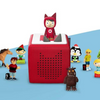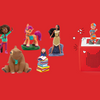How Does Stacking A Puzzle Affect The Child's Development?
Laying the puzzle, stimulates the creativity of the child, teaches concentration, planning own activities and design skills. According to American research published by the journal Developmental Science, children between 2 and 4 years old, who play with the puzzle, later have better spatial abilities which improves a child's development. Puzzles are associated mainly only with fun, but since they can do much more than take care of our child, it is worth to take a closer look.
Laying the puzzle, stimulates the creativity of the child, thinking about activities and design skills.
What puzzles are there for a child to choose to improve child's development?
Having fun with simple puzzles with large elements, we can start with an 18-month-old child, when slowly begins to explore the surroundings, distinguish shapes and colors .. At this age, it is good to give the child a puzzle consisting of large elements, so that they can not swallow them. Let's start with a few elements, and when we notice that the child is bored, slowly start to increase their number. Remember not to overdo it, because instead of entertainment and valuable learning, we can treat unnecessary stress to your kids.
The adventure of a child with large pieces of puzzles can start around the age of three. When choosing a puzzle for a three-year-old, it's worth starting with small pictures. It should be clear, its colors determined, and the presented elements separated by visible outlines. It is worth choosing a puzzle with your child's favorite fairy-tale hero. If he loves Winnie the Pooh, he will certainly find it much fun to arrange the puzzle with his favorite.
Puzzles also for young people to improve child's development
Stacking puzzles is an interesting way for young people to spend time. Fun with puzzles stimulates an individual, social development and creativity. It is also an excellent quietening activity that teaches concentration and requires a goal-oriented activity. Puzzles for youngsters are different from those used by children. The individual elements have a smaller size, and the image is more complex - it can. For example, present landscapes or building structures.
Stack the puzzle together with the children
Children need attention and closeness of their parents, and having fun together is a great time to get to know one another. Also to strengthen family ties and positively influence the building of relationships for life. What's more, having fun with the child, the parent has a chance to become a role model and strengthen their authority. One of the possibilities of having fun is putting together a puzzle. Family puzzle arrangement not only teaches children to collaborate, but also integrates family members and helps them to get to know their relatives better.
All the best,
Amousewithahouse




